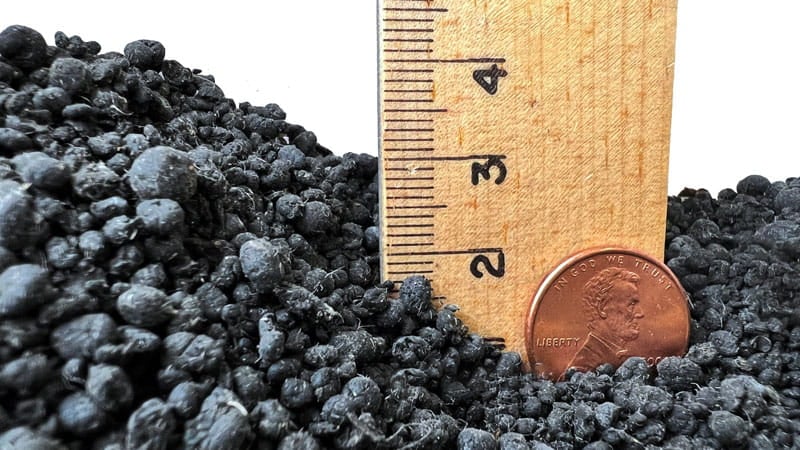The Thin Film Dryer is flexible with the end product dryness it produces. Product can be partially or fully dried between 30-95% DS for use in fluidized bed incineration, incineration, composting, landfilling, gasification, pyrolysis, agricultural use or more.
The dried sludge can meet Class A biosolids defined by 40 CFR Part 503 for pathogen reduction by:
The Thin Film Dryer meets the vector attraction requirements of Part 503 requirement by:

A unique feature of the Thin Film Dryer is it can be modified to change the output dry solids (%DS) as a plants process needs change, making the most flexible dryer on the market.
The Thin Film Dryer outputs pellet like material with a density greater than 40lb/cuft. The size of the pellets decrease as the material is dried to a higher %DS in the dryer. When combined with the optional linear dryer, the dryer system can configure the output pellet size in a low dust product.
If the dryer output is not suitable for an application, LCI’s experience in granulation can help tailor the dried sludge product to a specific size including use of pellet mills and granulation.

The Thin Film Dryer is an indirect dryer which uses thermal oil, steam, or hot water to heat the dryer. The dryer can work with a myriad of heat sources including natural gas, digester gas, electricity, solar energy, waste heat sources and more.
Typical heat requirements are:
Typical Limits for the heating medium are:
Higher temperatures are not recommended for drying due to a decrease in drying efficiency from the Leidenfrost (Film Boiling) effect.
The Thin Film Dryer heating process is designed with configurability and sustainability in mind. There are many options for the dryer to help mitigate climate change.
Recent Developments with the Thin Film Dryer allow for even greater efficiency gains. For example,
Furthermore, the basic dryer design can be reconfigured with upgraded heat recovery or vacuum drying systems in the future to reduce heat consumption and the effects of greenhouse gas emissions and carbon footprint.
Please contact LCI for additional details on these processes and how we can help create a sustainable dryer project for you.
Thin Film Dryers were developed with safety in mind.
Furthermore, LCI will work with you to develop the design based on the latest National Fire Protection (NFPA) codes and work with your Dust Hazard Analysis team to ensure the entire process is safe from fire and explosion.
The Thin Film Dryer is simple and easy to maintain. The system has a single wear part, the blade, which is bolted to the edge of the rotor. Typically, the blades are inspected yearly using a preconfigured trolley system to pull the auger.
Blades which are worn are simply unbolted and replaced. All maintenance is performed at the floor level without heaving lifting, draining of heating fluid, and, factory synchronization or re-alignment of the equipment.

Due to the nature of sludge, there is a risk of odor from the drying process as well as dust production. Many sludges contain sulfur-containing compounds such as Hydrogen Sulfide (H2S), Ammonia (NH3) and Volatile Organic Contaminates (VOC’s) such as amines (Guide To Field Storage of Biosolids - Chapter 2) You should consider your local air regulations when designing and sizing a dryer.
To lessen the impact of the cost of emissions control equipment, the Thin Film Dryer is designed with a small airflow (typically between 20-200 CFM) meaning there is a small volume of air to treat compared to other technologies like belt dryers and drum dryers. The first line of defense is a barometric/mixing condenser which precipitates out most of the liquid evaporated out the dryer and curb dust emissions.
Next, if required, the small air flow can be sent to a small odor control system, an existing odor control system or to the thermal heating system to be oxidized, reducing the cost of the overall system.
For more detailed information please reach out to our team to discuss your particular application requirements.
With over 100 drying applications completed, LCI and our partner SMS-BUSS-Canzler have the process knowledge to design your drying application. With the following information we can start the design process:
With this information we develop design for your application by using our internally developed heat transfer coefficients based on our years of experience in evaporation and drying. Once the dryer is sized our team can put together a price estimate for the dryer.
Contact Us Today!
Chip Pless - Sludge Drying Sales Manager
Phone: 704-397-4082